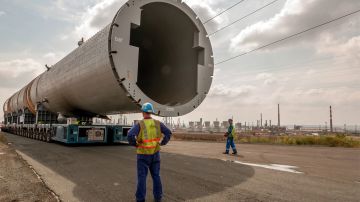Safety is the highest priority for senior management and employees across INEOS’s 15 operating businesses. But continuous improvement needs continuous focus and from the start of 2012, the company is taking the level of commitment to another level.
INEOS continues to see an improving trend in its safety performance across its individual business units but in January, INEOS Group operations director Tony Traynor will take on responsibility for health, safety and environment (HSE) at a group level, with a key oversight role for process safety and safety culture. “My role”, he says, “is all about enabling things to happen and making sure we get the most from shared best practices from across our businesses and others in the industry.”
Traynor will be in a position to take a view across the entire company. So that, “if we identify some trends that need to be addressed, then I can engage with the operations directors [in the businesses] and work together on any problems.” He will also review the results of investigations into any near misses or incidents that do happen and ensure that any concerns are addressed and learning shared.
He explains, that it has always been essential that all INEOS businesses report monthly on all critical safety matters and reliability of assets, with operations directors responding to the CEOs ofeach business. This focus has already paid off, with the injury rate for INEOS employees and contractors, for example, having halved twice over the past decade, from 0.81 classified injuriesper 100,000 work hours in 2002 to 0.19 in 2011.
In terms of key parameters, INEOS focuses most closely on personal injuries, environmental performance, non-compliance with regulations, asset integrity and loss of containment, inspection rates, and incidents/near misses. For the latter, says Traynor, there is a vital system in place for reporting and measuring near misses. “The more near misses we know about the greater the chance of us learning from these and preventing real incidents from happening. For this reason we actively encourage our staff to report everynear miss.”
Traynor, who gained a background in manufacturing with ICI Acrylics before becoming operations director, first at INEOS Chlor andthen INEOS Refining, explains that as a business INEOS has three critical success factors: “Number 1 is to operate our plants safely; Number 2 is to run the plants as hard as we can and number 3 is to operate at the lowest sustainable cost base. Efficiency, reliability and safety of operations are all linked and are critical to the success of allour businesses.”
To drive improvements in safety performance, Traynor has been leading an initiative of the INEOS process safety management team to develop two sets of 10 key principles that will set the standard across the company. These have been developed using experience and learnings from within INEOS over the years, but also with regard to external learning, gained from well known incidents such as BP’s Texas City explosion and the Buncefield storage tank explosion in the UK.
Traynor is well placed to bring this external learning to bear, as he was chair of the UK’s Process Safety Leadership Group, set up in 2007 after Buncefield and tasked with driving forward high standards in process safety leadership and to complete the implementation of the Buncefield investigation’s recommendations across the industry.
One set of principles, explains Traynor, deals with process safety management, while the second set addresses human factors, or safety culture and behaviour. “These are not procedures that we are issuing,” he stresses, “but principles that describe the way we operate.” These will be shared with everyone in the company over the course of this year.
The process safety principles are aimed at the technical level to ensure the right leadership and values are in place, to maintain asset integrity, says Traynor. “For safe operation we want to keep the plant always in the safest possible state, this will always mean putting safety ahead of production. There are a number of things you have to have, such as experienced people with the right training. It is vital to maintain the assets properly and to do the right amount to ensure their integrity. We want to avoid loss of containment, as that is the basis of the safety of our plants.”
On the human factors side, he adds, “it’s really about instilling the right values and behaviours, so that people understand that we do not put production ahead of their safety. We don’t expect individuals on the plants to take risks and so we need to encourage the right culture and ensure proper risk assessments are in place.”
Traynor adds that the principles apply generally, so that everyone who works on an INEOS site will be protected. “We don’t want different values on individual plants, and we don’t want INEOS employees and contractors to be regarded any differently from one another.”
Given INEOS’s history of growth by acquisition, there has been a broad range of cultures across the Group. But, says Traynor, “Safety is our highest priority and from this basis we establish common values and principles. How these are ultimately delivered will be influenced by culture, but the key thing is that they are delivered.”
Traynor knows that he is building on an already creditable safety performance and one that is still improving. INEOS operates well within the first quartile of petrochemical companies in terms of classified injury rates. Some producers, he adds, have rates twice as high as INEOS. But then again, he remarks, “We see Exxon Mobil as best in class we are not as good as them yet, but we are not that far behind!”
For the coming year in his new role, Traynor stresses his passion for seeing continual improvement in Safety, Health and Environmental performance. His main priority is to visit INEOS sites to discuss his views and to share his thinking behind the two sets of principles. “I want people to understand them, take them on board and implement them”, he notes.
Of course, he acknowledges, the businesses are not starting from a blank page. All the businesses already have their own safety management systems in place. “What I want them to do is take the new principles and hold them up against their existing systems and see how they measure up. They can then learn and move forward. With the group-wide oversight, I think we can accelerate our learning and continue to see an improving track record,” concludes Traynor.















